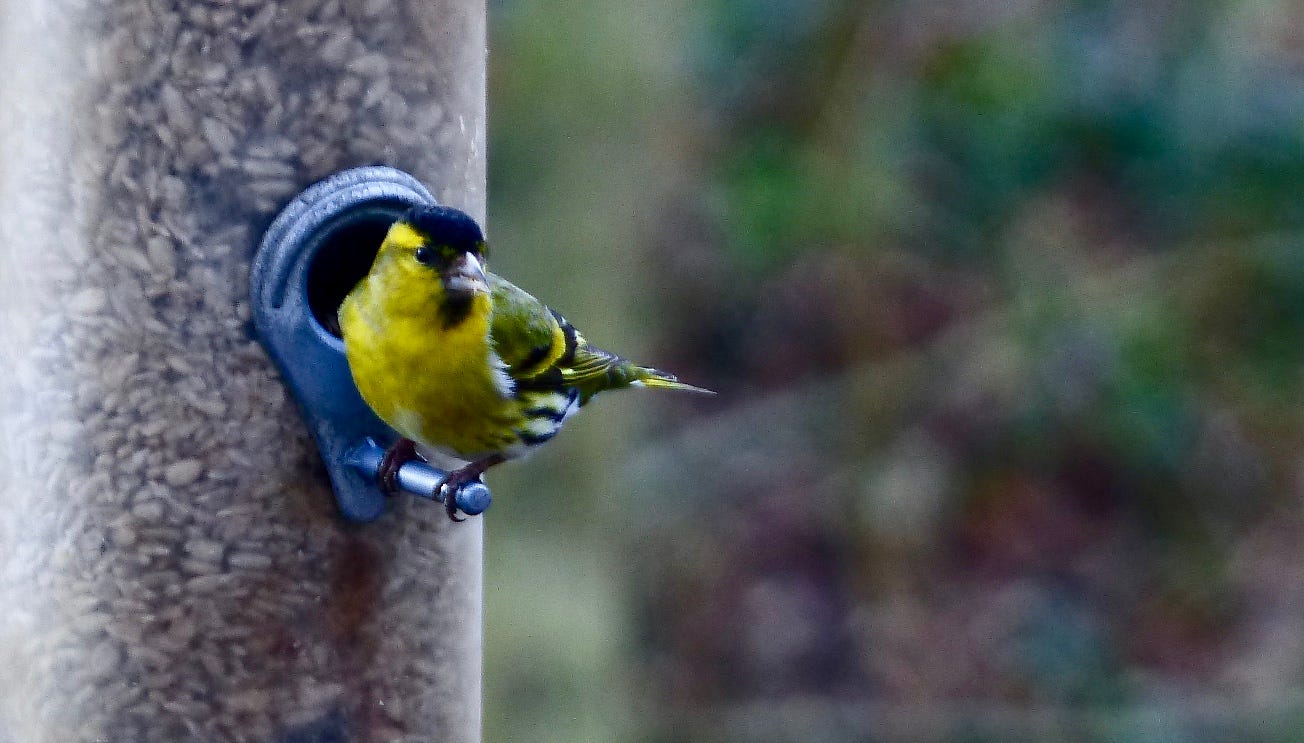The Year of 100 Birds – Week 6
Swans etc | Crow | Siskin | Starlings | Birds-of-paradise
Hello. Welcome. Thanks for being here.
Every week in 2025, as well as the regular Six Things posts, I’m writing about birds. If birds aren’t your thing, perhaps I can lure you into their evil world. And if no absolutely not, then you can always toggle your preferences so you only get what you want.
For those who stay, there will be:
– a bit about my birding activities that week
– micro-essays about two British birds
– a couple of news-y or science-y or otherwise of interest bits from elsewhere
I hope you enjoy it all.
Swans etc
I saw some birds this week. Honestly, it’s hard not to.
There were the mute swans from a train window. Three of them, apparently plonked at random in the middle of a field. White scatter cushions in the gloaming, so cold and dank and wet that you can’t help but wonder if they wouldn’t rather be indoors.
Ten gulls circling lazy-style overhead, the air doing all the work. Trace their gently curved, interlocking paths, and the pattern will mean something, probably. At the very least it’ll be something to look at and wonder if there is a larger geometry at play, a power beyond our ken, hinting at a more intelligent force. Probably not, though. They’re only gulls, chilling on a Wednesday afternoon.
A little egret on seashore rock, splash of white on black, a monochrome delight on a blasted afternoon.
Three dunnocks mouse-like on the path, tarmac-pecking for scraps – minuscule invertebrates, insects, seed fragments. Invisible to us, inconsequential; the stuff of life for them, the difference between survival and not. They wait till I’m close – this close – then into the hedge they dart. Twenty yards on, I glance back. There they are again. Peck hop hop peck peck hop.
A robin, singing. Always bloody singing. Ok, we get it. Give it a rest. Wondrous silver ribbon of uplift.
Carrion Crow

You can’t remember every bird you see. That would be ridiculous. But there was this one crow. Over the A205, it was, rowing gamely through the air. A normal enough sight. There are loads of crows round our way. But the thing that made it linger in my mind’s eye was the huge polystyrene burger tray – longer than the bird itself – it was carrying in its beak. It was early March, nest-building season – obviously the quality of west Dulwich twigs just wasn’t up to scratch. Not exactly the most aerodynamic of accessories, but no doubt it had done all the calculations and figured it was worth the effort.
I love a crow. But while I might welcome their relatively benign presence on my suburban patch, for many centuries (and still, no doubt, in certain parts of the country) this declaration would have been met with anything from an uncomprehending look to raw fury. Long reviled as harbingers of evil and misfortune, their irksome habit of predating the eggs and nestlings of other birds is one factor in their historical unpopularity. And when you consider that their diet of carrion will also have included human flesh, our visceral dislike for them, fostered over centuries, becomes more understandable. No wonder Daphne du Maurier (and of course Hitchcock in the film adaptation) chose them along with gulls as the instigators of the terror campaign against humans in The Birds. Nowadays, adapting to survive, gulls and crows vie with each other for the status of leading urban scavenger – and their prowess in that department will still elicit a curse or two from the intolerant or unwary.
And yet, and yet. Look at that plumage, as black and glossy as a Spinal Tap album; look at that jaunty, rolling gait – a touch of the wide boy; and look at the stout curve of its bill.
Clever birds, they are. Give them a full bin and they will extract maximum value from it. They might also drop molluscs from a height to smash them open. You wouldn’t bet against them perpetrating a basic phishing scam.
And just watch a carrion crow flying in wind, loose and floppy like a handkerchief, wings folding in on themselves, allowing the wind to take it just so far, waiting for the lull and then, with deceptively lazy beats, drawing itself up and through and away. What a fine thing.
We have a local favourite. It sits in the cedar next door and bellows out a series of long, drawn-out caws, neck extended, as if summoning the other crows to prayer. Graaah-ik – graaaah-ik – graaaah-ik.
We always say hello. It would be rude not to.
Siskin
We like a success story. Something bucking the downward trend, thriving and spreading as never before.
Take the siskin. Little finchy streak of yellow-green and black. Sweet, endearing and chatty, they go absolutely gangbusters for a seed – in particular, pine and Sitka spruce. And that’s been the secret of their success in the last half century or so, their population tracking closely with the increased popularity of conifer plantations. The growth and spread is striking: population up 35% since 1995, with a corresponding 167% spread of their distribution. Hurrah.
You’re most likely to see them around now, just before the breeding season. During winter they roam in gangs, looking for food sources to exploit. If you have a garden, are near a clump of Sitka spruce, and are one of the millions of people fond of feeding birds, you might be in luck. Urban adopters, they are – not entirely dependent on our resources, but very happy to exploit us to their own advantage. Hanging plastic tube of seeds, anyone? Thanks. I’ll have two.
Niche siskin fact: formerly popular as a caged bird, they were known to fanciers as ‘aberdevine’.
Oh that’s an interesting word, I think. I wonder if I can find anything about its derivation or etymology online?
Up to a point.
I can picture the meeting.
“OK team, our luxurious, responsible, ethical and innovative lawn-zhray startup is good to go. All we need now is a name, something that truly reflects the values of lawn-zhray that liberates.”
“I think I have it, boss.”
“Shoot.”
“Aberdevine.”
“Aberdevine?”
“Aberdevine.”
“I love it. Sophisticated, sensual, different. What does it mean?”
“It’s…”
“Well?”
“It’s…”
“Spit it out, man!”
“It’s an old name for a small, seed-eating song bird, boss.”
“By George, I think you’ve got it! ‘Aberdevine lawn-zhray – lawn-zhray for songbird lovers everywhere.’ Roll it out.”
“Right, boss.”
Starlings
The “ornithographies” of Xavi Bou have long been favourites of mine – stunning images using clever photographic techniques to render the movement of birds. And now there’s a short film, equally beautifully rendered.
Paradise birds
I always knew birds-of-paradise were magic. As well as their wonderful plumage, often spectacular tails and magnificently showy courtship displays, it now turns out they exhibit biofluorescence too.
And of course mention of birds-of-paradise is simply an excuse to trot out the one that treated David Attenborough with such scant regard for his celebrity and the exigencies of filming schedules.





I think David was having almost as much fun as the bird!
Saw my first Siskin in my suburban garden this year :-)